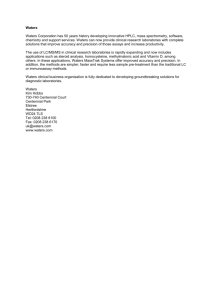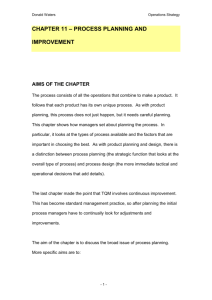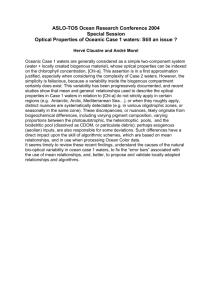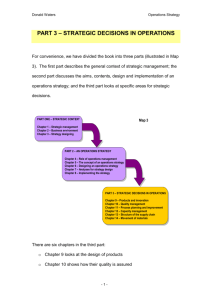CHAPTER 12 – CAPACITY MANAGEMENT
advertisement
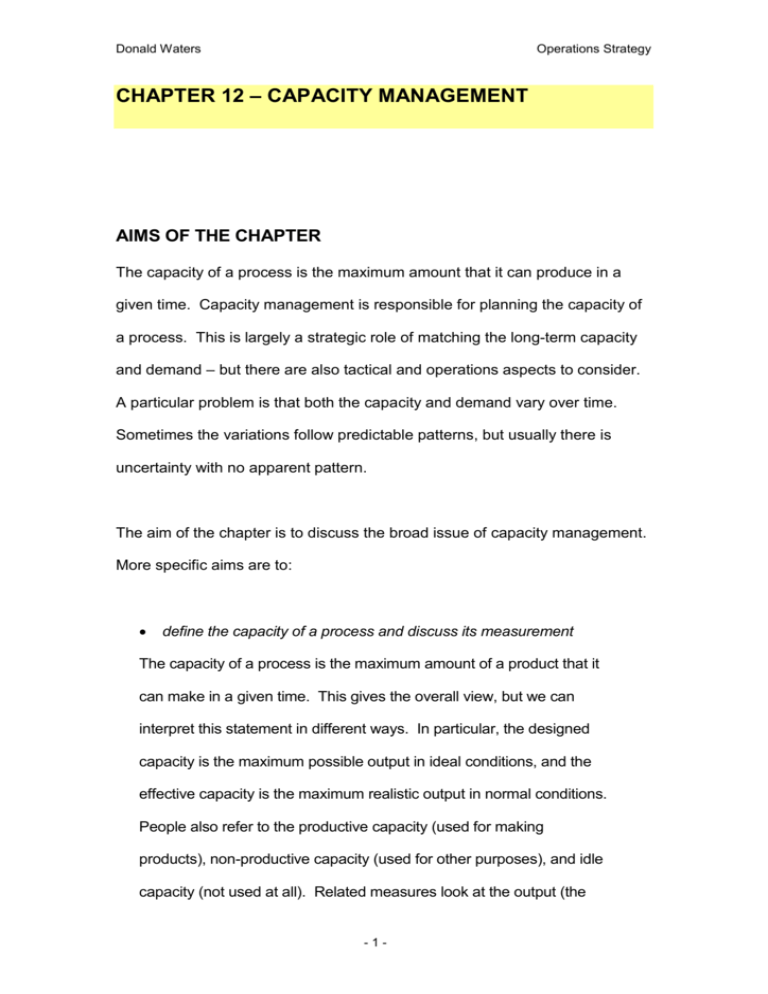
Donald Waters Operations Strategy CHAPTER 12 – CAPACITY MANAGEMENT AIMS OF THE CHAPTER The capacity of a process is the maximum amount that it can produce in a given time. Capacity management is responsible for planning the capacity of a process. This is largely a strategic role of matching the long-term capacity and demand – but there are also tactical and operations aspects to consider. A particular problem is that both the capacity and demand vary over time. Sometimes the variations follow predictable patterns, but usually there is uncertainty with no apparent pattern. The aim of the chapter is to discuss the broad issue of capacity management. More specific aims are to: define the capacity of a process and discuss its measurement The capacity of a process is the maximum amount of a product that it can make in a given time. This gives the overall view, but we can interpret this statement in different ways. In particular, the designed capacity is the maximum possible output in ideal conditions, and the effective capacity is the maximum realistic output in normal conditions. People also refer to the productive capacity (used for making products), non-productive capacity (used for other purposes), and idle capacity (not used at all). Related measures look at the output (the -1- Donald Waters Operations Strategy amount of product actually made), productivity (the amount produced for each unit of resource), utilisation (proportion of designed capacity that is actually used), efficiency (proportion of the effective capacity actually used) and effectiveness. understand the aims of capacity management Capacity management is responsible for all aspects of operations’ capacity. It is generally responsible for matching the long-term capacity of a process to the demand for its products. It does this through capacity planning, which describes more specific methods for achieving this match. An important point is that every process has a bottleneck where resources or facilities limit the overall output. describe a general approach to capacity planning The chapter develops a general approach to capacity requirements planning based on six steps: 1. consider demand and translate this into a required capacity for the process 2. find the capacity already available in the process 3. identify mismatches between capacity needed and that available 4. suggest alternative plans for overcoming any mismatch 5. compare these plans and find the best 6. implement the best. Each of these steps has its own problems. consider the timing and size of capacity changes There are continuous changes to operations – brought about by changes in the environment and internal adjustments – and these often need adjustments to process capacity. The first question here concerns the timing of changes, and whether it is generally best to work with spare capacity or some shortage. This -2- Donald Waters Operations Strategy balance depends on the relative costs of unused capacity and shortages, with factors that encourage early expansion including variable and uncertain demand, high profits margins, high cost of unmet demand, low costs of spare capacity, continuously changing product mix, variable efficiency, and capacity increases that are relatively small. The second question concerns the size of change, and whether it is better to have a few large changes or more small adjustments. Factors that encourage a few large expansions include the benefits of capacity staying ahead of demand for a longer time, a cushion against unexpected conditions, fewer disruptions, lower costs per unit of expansion, earlier economies of scale, potential to encourage more demand, and giving some advantages over competitors. discuss reasons why capacity changes over time There are many reasons for this. The chapter illustrated systematic changes due to learning effects, maintenance, replacement policies and the business cycle. Superimposed on these patterns are short term variations due to staff illness, interruptions, break-downs, weather, holidays, enthusiasm of employees, fatigue, and so on. appreciate the need for shorter term adjustments to capacity Capacity planning is largely a strategic function, setting available capacity over the long term. But demand can change very quickly, by the day or even the hour, so managers need the flexibility to make short-term adjustments to their effective capacity. There are two ways of doing this based on supply management or demand management. Each of these is appropriate -3- Donald Waters Operations Strategy circumstances, and the choice depends on the balance of costs and benefits. DISCUSSION QUESTIONS 1. Why is capacity management a strategic issue? To what extent do tactical and operational factors influence the capacity? Capacity management is a strategic issue, because capacity is an important issue, with effects over the long term, involving high cost, made by senior managers – and all the other features of strategic decisions. At the same time, in common with most other types of decision, there are tactical and operational factors to consider. For example, a company might decide to open a call centre in a particular location. Its capacity is a strategic decision, as this cannot be changed in the short term, and any expansion would need another building and extra facilities. But staffing patterns might be tactical decisions set for a few months. Then on a particular day, operational decisions decide exactly who is working. So the context is set by the strategic capacity decision, and this is adjusted in the light of requirements with tactical and operations decisions. 2. Capacity is not really an absolute limit on the output from a process, but it is a measure of management performance. Do you agree with this? Yes – to a large extent. The evidence to support this comes from different organisations – and even different managers – can use exactly the same facilities and get different levels of output. The implication is that some managers can use facilities more efficiently, increasing production – and effective capacity. Further evidence comes from the observation that capacity -4- Donald Waters Operations Strategy changes over time. If managers can control these changes more efficiently, then they can increase effective capacity. Of course, there are limits to the extent that capacity is a measure of management rather than some fixed limit, and it would be difficult to consistently get higher output than the designed capacity. 3. You often see notices at the entrance to pubs, clubs, halls and other buildings saying that, ‘The capacity of this facility is 200 people’. What does this really mean? Sometimes there might be physical limits on capacity, such as the number of seats in the facility. Often, though, there is no physical limit and the capacity is an arbitrary number that is set to reflect some other concern. For example, fire regulations might set a maximum acceptable time for everyone to leave a club through the emergency exits – and then capacity of the club is set by its evacuation procedures. But again, this is based on an arbitrary decision about evacuation times. Generally, such notices mean that someone has taken a decision – based on some criteria – that this should be the capacity of the facility. 4. Is it always possible to find the capacity of a process? How can you find the capacity of a shopping mall, national park or a shipping lane? Can you give examples where it is difficult to find a capacity, and say how these difficulties are overcome? Not really. The examples given are only a few of the many possible ones where -5- Donald Waters Operations Strategy it is difficult to set a real – or even convincing – capacity. The way of overcoming them is to use agreed – but generally arbitrary – measures. 5. Is it better to have frequent small changes in capacity, or fewer large ones? This depends entirely on circumstances, and the relative costs of making the expansion and having spare capacity. Factors that encourage a few large expansions include the benefits of capacity staying ahead of demand for a longer time, a cushion against unexpected conditions, fewer disruptions, lower costs per unit of expansion, earlier economies of scale, potential to encourage more demand, and giving some advantages over competitors. 6. Why does capacity change over time? There are many reasons for this. The chapter illustrated systematic changes due to learning effects, maintenance, replacement policies and the business cycle. Superimposed on these patterns are short term variations due to staff illness, interruptions, break-downs, weather, holidays, enthusiasm of employees, fatigue, and so on. And then there are apparently random variations that cannot be explained. 7. Capacity planning is a waste of time. Long-term forecasts of demand are unreliable, and both capacity and demand vary in unknown ways. So organisations should simply get enough capacity to cover likely demand for the future. What do you think of this view? In some conditions this is a reasonable view. When extra capacity is cheap and lost custom is expensive, it makes sense to have as much capacity as -6- Donald Waters Operations Strategy necessary to meet all potential demand. But usually managers have to find a compromise that balances the cost of capacity and lost sales. If, for example, capacity is expensive and lost custom is cheap, then it would make sense to limit capacity to the level that gives the best operations. The usual solution comes between these two, and managers have to consider all factors and choose the amount of capacity that best meets their aims. Included in their decisions is an assessment of the risks and uncertainties in their forecasts for demand and factors affecting capacity. 8. Nobody would seriously consider limiting demand for a product, but would always look for ways of increasing process capacity. Is this true? No. Many organisations limit demand for a product – or the amount they actually supply. For example, luxury goods, portrait painters, football stadiums, university courses, professional institutions, limited edition prints, medical practices, bespoke tailors, etc all put artificial limits on their sales. The reason is simply a balance of the benefits of meeting demand with the costs involved. When the costs of expanding are higher than the benefits, it makes sense to limit capacity. IDEAS IN PRACTICE Forthright Communications Inc. Aim: to illustrate some calculations of capacity and related performance -7- Donald Waters Operations Strategy This case shows some calculations associated with the capacity of a central process in a communications company. These figures are not an end in themselves, but they highlight areas where improvements might be made. For example the utilisation was 74 percent, and this might seem rather low – effectively resources are standing idle for more than a quarter of the time. The analyses of non-productive use and wasted capacity show why this occurred. Then managers can consider these areas and start looking at ways of reducing the waste. SunAlto Orange Aim: to illustrate the calculation of process capacity. The capacity of an overall process is set by the capacity of its limiting bottleneck. This case describes a fairly short process, each part of which has a known capacity. The packing equipment forms the limiting bottleneck, and the overall capacity can only be increased by increasing the capacity here. The process is not balanced, so each part has a different utilisation. Usually managers want a balanced process where all operations have virtually the same capacity. Global Car sales Aim: to illustrate some problems in defining capacity The car industry is characterised by high capital investment in automated production. This is only profitable when capacity is carefully matched to -8- Donald Waters Operations Strategy demand, and plants get high figures for utilisation and productivity. In recent years, it is widely felt that there is considerable excess capacity, and this has lead to a series of mergers and take-overs. However, a closer look begins to question this picture. It takes several years to increase capacity in a car plant, so there must be some cushion to allow for variations and sudden growth in demand. At the same time, the capacity comes in different forms, with some being more apparent than real. If we take these into account we can argue that there is not really any over-capacity in the industry, but capacity is quite closely aligned to demand. KDF Resources GmbH Aim: to introduce the type of calculations involved with capacity planning This case illustrates some of the initial considerations when a company starts to look at plans for expanding capacity. Here the company has increasing demand that can only be met by increasing capacity. So it looks at the alternatives available – expansion on the existing site, or one, two or three new centres – and starts to compare these. The costs suggest a single large centre, but managers then have to consider a range of other factors, including the risks associated with mismatches between supply and demand. The book develops this type of approach into a formal procedure for capacity requirements planning. GlaxoSmithKline Aim: to illustrate the effects of economies of scale on growth in one industry -9- Donald Waters Operations Strategy This case outlines the steps that one company has taken on its move from a small single company to become one of the world’s largest pharmaceutical company. The thinking behind this growth is that it is very expensive to develop new drugs, and research companies can get considerable economies of scale. A company can have organic growth, but this often gives an industry excess capacity. In this case it was felt better to grow by a series of mergers with similar companies. There are other examples of this, including retailers, banks, television companies, telephone operators, and car manufacturers. Wholefood Preparation Ltd Aim: to outline some cost calculations for equipment replacement The age and condition of equipment has a direct effect on capacity, with older equipment usually reducing capacity (due to increase breakdowns and generally deteriorating performance). Managers have to make decisions about the best time to replace equipment, generally balancing the costs of buying new equipment and continuing to operate older equipment. This case illustrates the way that an operations manager approached this decision for production machines in one food preparation company. These costs give a starting point for further analysis. European Car Manufacturers Aim: to show the effects of perceived over-capacity in one industry - 10 - Donald Waters Operations Strategy An earlier case considered the effects of over-capacity in global car manufacturing. This case shows the effect in Europe, where over-capacity is seen to be a significant problem. Companies want to increase the utilisation of their own facilities, but this is difficult in a competitive market. The path taken by the industry is to reduce the number of companies working, so that production is concentrated into fewer more efficient operations. The direct result is a series of mergers, takeovers and closures. CASE STUDY – HEATHROW AIRPORT Decisions about capacity often have expensive consequences. This is particularly noticeable with airports, where any expansion is expensive in its direct costs, environmental impact, effect on local communities, and so on. Heathrow is London’s main airport and is one of the busiest in the world. Demand for air travel around London continues to grow, but Heathrow’s limited capacity means that much of this has been transferred to other airports. Gatwick, Stansted and Luton have all had major expansions, and all have plans for yet more capacity in the future. For a long time Heathrow’s capacity has been limited by the bottleneck at its passenger terminals. The fifth terminal will remove (at least for some time) this limit and increase overall capacity. How can BAA measure the capacity of Heathrow? What factors affect this capacity? - 11 - Donald Waters Operations Strategy The capacity of an airport is usually stated in terms of the number of passengers that can use it in a year. This, in turn, depends on the number of other measures, particularly: o Air-side operations – largely the number of passengers that planes can deliver and take away, determined by the number of runways, time slots available for planes to land and take-off, size of planes, occupancy, etc o Land-side operations – largely the number of passengers that the terminal buildings can handle, dealing with all aspects of arrivals, departures and associated services. For each of these, BAA can use many related measures for specific aspects of capacity. As usual with capacity, the actual limits are largely a matter of agreement than physical limits. For example, the separation of planes is an agreed distance that is considered safe, and the number of check-in desks is set by agreed levels of customer service. Larger planes, greater occupancy, more time slots for take-off and landing, and new systems have already increased capacity of the Heathrow. For a long time the bottleneck has been identified as terminal capacity. The fifth terminal will remove this (or more accurately move it to another part of operations). The new terminal improves both air-side and land-side operations, removing current bottlenecks and significantly increasing overall capacity. For years, Heathrow has been operating beyond its designed capacity. What effects does this have? The planned capacity is a theoretical limit, so when this is exceeded it means - 12 - Donald Waters Operations Strategy that the limit has somehow been raised. Saying that the airport is working beyond its designed capacity really means that it is working more efficiently than expected and is finding ways of dealing with more passengers than expected. But the capacity is largely an agreed measure, and obviously does not reflect the maximum number of people that could fit into the space. It would really be fairer to say that the airport is working beyond its agreed effective capacity. This presumably means that some facilities – those at the bottlenecks – are stretched beyond their limits. This can raise many related problems and inevitably means that customer service declines. Airports like Heathrow continue to expand. What will eventually limit their capacity? This is difficult to answer. It seems that the current growth in demand for air travel is likely to continue for the foreseeable future, in the way that road travel has been expanding for well over a century. But there must ultimately be some limits, and these might come from several sources. Air travel might become less popular, perhaps because of changing social habits, costs, population levels, attitudes towards the environment, options for alternative types of transport, etc. In the shorter term, airports might increase the capacity of current facilities by using them more efficiently, installing better systems, and generally improving operations. For example, introducing automation (as described in the case for IATA) can dramatically increase the number of passengers who can check-in through current facilities; improving control systems can increase the number of plane movements; new planes can increase passenger density. - 13 - Donald Waters Operations Strategy - 14 -
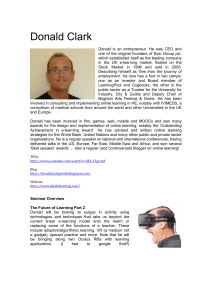

![[#SWF-809] Add support for on bind and on validate](http://s3.studylib.net/store/data/007337359_1-f9f0d6750e6a494ec2c19e8544db36bc-300x300.png)

